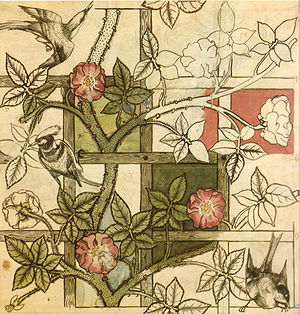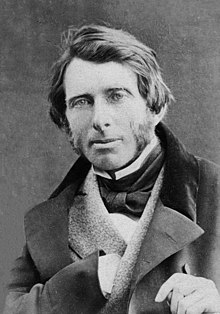New Movie highlights the beginnings of the Arts and Craft Movement in England
[Previous post: Ballarat Federation Heritage .. Next post: ]from the Telegraph.co.uk
Gorgeous Arts and Crafts homes that Effie Gray would have loved
Emma Thompson’s new film tells the story of Effie Gray and the art critic John Ruskin, as well as the roots of the Arts and Crafts movement. Caroline McGhie finds properties that capture its legacy
 |
| Emma Thompson and Dakota Fanning in Effie Gray |
Victorian values: Emma Thompson and Dakota Fanning in Effie Gray Photo: Sovereign Films

By Caroline McGhie
7:00AM BST 13 Oct 2014
Comment
A good Victorian melodrama is nothing without its setting. Dark streets pooled with yellow lamplight, railway engines swirled in steam. The sitting rooms are heavy with patterned wallpapers and fabrics, the bathtubs have clawed feet and kitchen shelves are stacked with copper pans and jelly moulds. The tensions between the exteriors and interiors, the dark alleys and the front parlours, have been at the heart of many a screen drama.
- Few are quite as scandalous as Emma Thompson’s new film Effie Gray, which tells how Effie, married to the art critic John Ruskin, fell in love with her husband’s student, John Everett Millais.
- Dakota Fanning plays Effie, Greg Wise is Ruskin and Tom Sturridge is Millais, with other celebrity turns from James Fox, Thompson herself, Claudia Cardinale, David Suchet and Derek Jacobi.
The Arts and Crafts movement was an international design movement that flourished between 1880 and 1910, especially in the second half of that period,[1]continuing its influence until the 1930s.
The movement developed first and most fully in the British Isles,[2] but spread across the British Empire and to the rest of Europe and North America.[4] |  William Morris design for "Trellis" wallpaper, 1862 |
- Ruskin was a huge influence on William Morris. He gave us the Arts and Crafts movement and so many wonderful houses full of light and decoration.
- Ruskin might have struggled to appreciate the female body, but as a naturalist he had a huge appreciation of the wild.
- As an art and architectural critic he admired old-fashioned craftsmanship, both keystones of Arts and Crafts and the Aesthetic Movement.
 |
| John Ruskin 1863.jpg |
John RuskinFrom Wikipedia, the free encyclopediaThis article is about the art critic, John Ruskin. For the painting of John Ruskin by Millais, see John Ruskin (painting). John Ruskin in 1863 | |
| Born | 8 February 1819 54 Hunter Street, Brunswick Square, London,England |
|---|---|
| Died | 20 January 1900 (aged 80) Brantwood, Coniston,Lancashire, England |
| Occupation | Writer, art critic, draughtsman, watercolourist, social thinker, philanthropist |
| Citizenship | English |
| Alma mater | Christ Church, University of Oxford King's College London |
| Period | Victorian era |
| Notable works | Modern Painters 5 vols. (1843–60), The Seven Lamps of Architecture (1849), The Stones of Venice 3 vols. (1851–53), Unto This Last(1860, 1862), Fors Clavigera(1871–84), Praeterita 3 vols. (1885–89). |
| Spouse | Euphemia Chalmers Gray (1828–1897) (marriage annulled) |
John Ruskin (8 February 1819 – 20 January 1900) was the leading English art critic of the Victorian era, also an art patron,draughtsman, watercolourist, a prominent social thinker and philanthropist.He wrote on subjects ranging from geology to architecture, myth to ornithology, literature to education, and botany to political economy. His writing styles and literary forms were equally varied. Ruskin penned essays and treatises, poetry and lectures, travel guides and manuals, letters and even a fairy tale.
John Ruskin Quotes:The purest and most thoughtful minds are those which love colour the most. John Ruskin When love and skill work together, expect a masterpiece. John Ruskin | A little thought and a little kindness are often worth more than a great deal of money. John Ruskin Quality is never an accident. It is always the result of intelligent effort. John Ruskin Fine art is that in which the hand, the head, and the heart of man go together. John Ruskin |
- The ideas were revolutionary and the cross-fertilisation between art and architecture was rich.Bedford Park, in west London, was built from the 1870s to include the best of the countryside in the city.
- With parks, tennis courts and Queen Anne revivalist cottage styles, it became the model for the Garden City Movement. Sir John Betjeman hailed it as “the most significant suburb built in the last century, probably in the western world”.
Housing on Bedford Road | Bedford Park is a suburban development in west London, England. It forms a conservation area that is mostly within the London Borough of Ealing, with a small part to the east within the London Borough of Hounslow. It can be justly described as the world's first garden suburb.[1] Although it was not built in the co-operative manner like some later developments (Brentham Garden Suburb,Hampstead Garden Suburb) it created a model that was emulated not just by the Garden city movement, but suburban developments around the world. Sir John Betjeman described Bedford Park “the most significant suburb built in the last century, probably in the western world”. Herman Muthesius, the celebrated German critic who wrote The English House in 1904 said, "It signifies neither more nor less than the starting point of the smaller modern house, which spread from there over the whole country." | ||||
| William Morris Designer# William Morris was an English textile designer, poet, novelist, translator, and socialist activist. Associated with the British Arts and Crafts Movement, he was a major contributor to the revival of ...Wikipedia Born: March 24, 1834, Walthamstow, London Borough of Waltham Forest, United Kingdom * Died: October 3, 1896, London, United Kingdom
| |||||
| Edward William Godwin ArchitectEdward William Godwin was a progressive English architect-designer, who began his career working in the strongly polychromatic "Ruskinian Gothic" style of mid-Victorian Britain, inspired by The Stones ... Wikipedia * Born: May 26, 1833, Bristol, United Kingdom
|
 |
| Period setting: Effie Gray being filmed in Greenwich, London: |
"The soaring house prices and desirability of the Bedford Park area prove its success.
Derek Fletcher of John D Wood (020 8995 9394) is selling a five-bedroom property designed by one of the leading architects, E W Godwin, at £2.49 million.
“The family houses in leafy streets retaining all of the values of the country village – with a Tube station – made it special,” he says. “It is a very niche market which has always attracted artists and media types. Now it has been discovered by Kensington and Chelsea buyers downsizing.” Hence the arrival of restaurants with Michelin stars."
| Red House Ln, Bexleyheath, London DA6 8JF, United Kingdom |
- “The late-Victorian era was a very exciting time, a very identifiable architectural period full of innovation,” explains Dawn Carritt at Jackson-Stops & Staff. She negotiated the sale of the first Arts and Crafts home,Red House at Bexleyheath, to the National Trust, which has spent the last decade restoring it and revealing hidden treasure. The property was designed by Edward Burne-Jones for William Morris, finished in 1860 and described by him as “the beautifullest place on earth”.

Sir John Everett Millais, Bt ‘Ophelia’, 1851–2 - While the Effie court case was raising eyebrows in London, Millais was busy painting his world-famous Ophelia, now in Tate Britain. He was one of the original Pre-Raphaelites, along with William Holman Hunt and Dante Gabriel Rossetti.
- He used Rossetti’s lover Lizzie Siddall as his model – she lay in a bath of cold water and caught pneumonia in the process. In the painting, her body is couched in a forest of wild flowers. Morris’s wallpapers, covered in intricate flower patterns, are not dissimilar.
Social hierarchy was built into the houses. Most homeowners kept sitting rooms for use on Sundays, hallways were inlaid with the best tiles and ceiling mouldings to impress. Even the less well-off had a servant tucked into a bedroom under the eaves, and kitchens were dedicated engine rooms. “There was such a huge building boom between 1850-1870 because people could move out of the cities away from the smog and get to their place of work by train,” adds Dawn.
- “The transport infrastructure allowed building materials to be moved around the country, so we had terracotta from the Midlands, slate from Wales. And there were very detailed pattern books from which you could choose wallpapers, ceiling mouldings and fireplaces.”
- Cleanliness and moral rectitude were the order of the day. “This is also when bathrooms arrived with piped water and fixed baths instead of hip baths. The fittings were really built to last and a lot of the houses still have them.”
|
|
"GET THE ARTS AND CRAFTS LOOK"

The Arts and Crafts Country House: From the Archives of Country Life
1 Nov 2011by Clive AsletHardcover £26.00
More buying choices£14.99used & new(32 offers)

Arts and Crafts Architecture
11 Sep 1997by Peter DaveyPaperback £19.97
More buying choices£12.89used & new(40 offers)
Hardcover
£11.76used & new(7 offers)
- The book: The Victorian Society (020 8993 0355) Book of the Victorian House(Aurum Press, £20) by Kit Wedd.
- Textiles and wallpapers: Morris & Co (0844 543 9500).
- Paints: Papers and Paints, 4 Park Walk, London SW10 OAD (020 7352 8626).
- Tiles: Heritage Tile Conservation Ltd, Cwm Gweld, Church Stretton, Shropshire SY6 7D8 (01694 771527).
"FOR SALE - HOMES IN THE ARTS AND CRAFTS MOVEMENT TRADITION (UK)"
1. Wolford Lodge, Moreton-in-Marsh, Gloucestershire
Gentleman’s residence with three bedrooms, coach house, annexe, with lots of period details, £1.25m,Jackson-Stops & Staff (01386 840224).
2. Villa designed by Charles Voysey, Lyford Road, Wandsworth, London

Wood-panelled rooms, Portland stone windows, Voysey fireplaces, six bedrooms, pool, £4.4m, Savills (020 8877 1222).
3. The Old Vicarage, Milton Abbott, Devon

Made of rock-faced stone on the Duke of Bedford’s estate in the Lutyens style with Tudoresque diagonal chimneys, six bedrooms, £925,000,Jackson-Stops & Staff (01392 214222).
4. Artist’s studio house, Cheyne Walk, London

Grade II-listed, designed by CR Ashbee with three large studios and a cottage with its own studio, £10.5m,Savills (020 7581 5284). The road was a favourite haunt for artists, including Dante Gabriel Rossetti, William Holman Hunt and Daniel Maclise.



No comments:
Post a Comment